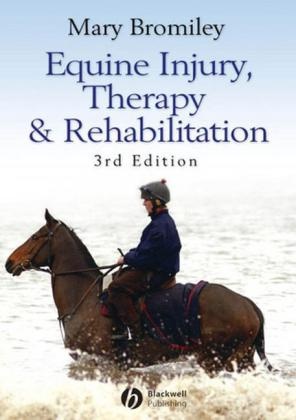Read more
Informationen zum Autor Mary Bromiley is a Chartered Physiotherapist. In 1984 she built Downs House Equine Rehabilitation Centre, now located on Exmoor, a world first for the treatment and rehabilitation of both horse and rider. She has written six books, and has been published internationally in six languages. She lectures world wide and for 18 years travelled as therapist to the medal winning New Zealand 3 day event team. Klappentext Mary Bromiley's book remains essential reading for both professionals and the general riding community. This new edition builds on the huge success of the previous editions, first published in 1987. Fully updated to reflect recent technological advances in diagnostic ability, as well as the proven physiological effects of light, magnetic fields and electrical currents on body tissues. This information allows readers to both understand and make an informed choice of appropriate therapy following a diagnosed injury. - Includes a discussion of basic equine anatomy; - Considers the evolutionary differences between man and horse; - Common equine and rider injuries are covered; - Explains in simple terms the horse's recovery processes; - Describes the need, and the appropriate methods used, to re-educate movement. Zusammenfassung * The original edition was the first book on the subject and it has continued to be a bestseller. * Covers a subject that is of worldwide interest. * The author is recognised as a pioneer at the forefront of this type of treatment. . Inhaltsverzeichnis Foreword by Martin Pipe CBEB ix Preface x Acknowledgements xii 1 The Musculoskeletal System Explained 1 Introduction 1 Members of the team 5 Interdependence of the body systems 9 Cells 9 Bones 11 Joints 11 Ligaments 12 Muscle 13 Tendons 14 The respiratory system 15 The heart 15 Circulation 16 The lymphatic system 18 The nervous system 19 The skeleton 19 The hind limbs 21 The forelimbs 22 Skeletal muscle 23 Reflex movement patterns 24 2 Injury - Effects, Repair and Causes 26 Common musculoskeletal injuries 26 Injury and repair 31 Possible causes of injury 35 Stable injuries 37 All-weather surfaces and gallops 38 Tooth problems as a cause of injury 39 The foot and shoe as a possible cause of injury 41 Saddles as a cause of injury 44 3 Problem Assessment 47 Soft tissue examination 48 Imaging as an aid to diagnosis 59 Ultrasonic scanning 60 Heart rate computers 61 4 Common Sites of Injury in the Horse 64 5 Therapy 76 First aid 80 Treatment 82 Massage 82 Hand massage 83 Mechanical massagers 86 Cold and heat 88 Cold and its uses 89 Methods of employing ice/water therapy 92 Heat 93 Cellular effects in response to varied stimulation 95 Magnetic field therapy, PMF (pulsed magnetic flow) and static magnet fields 96 Ultrasound 100 Light therapy 106 Laser therapy 109 Light emitting diodes 115 Electrical stimulation of muscle 115 Transcutaneous electrical nerve stimulators (TENS) 128 Manipulation 129 6 Rehabilitation 130 Reflex action 130 Muscle re-education 132 Passive movements 133 Rehabilitation aids 134 Hydrotherapy 137 Thalassotherapy 143 Long reining 149 Ridden work 158 Summary 159 7 The Back - Horse and Human 160 The horse 160 The human back 168 8 Common Rider Injuries 175 Rider injuries 175 Types of injury 180 General rehabilitation 184 Appendix I The Veterinary Act 185

